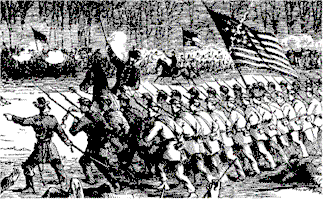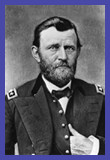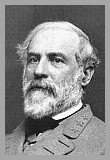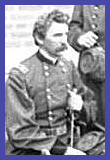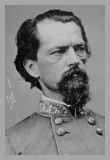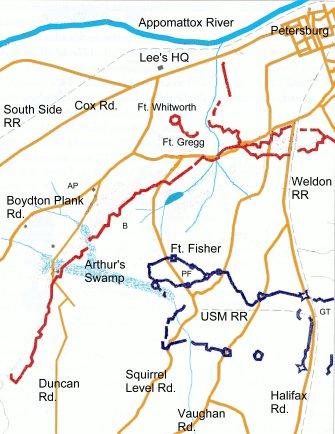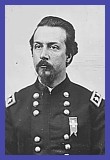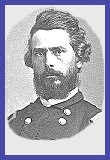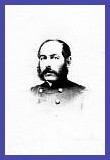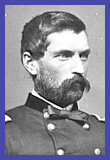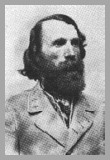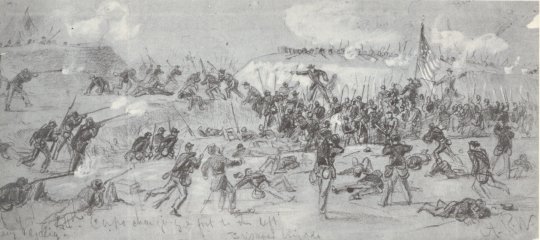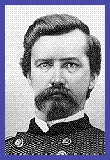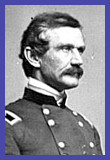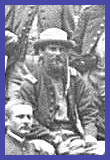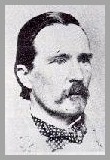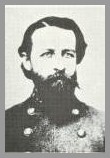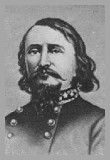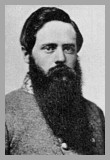Overview The debacle at Five Forks meant that Lee had lost his mobile reserve as an effective fighting force and therefore had no force to immediately oppose to Sheridan's combination of cavalry and infantry at Five Forks. He would have to thin his lines to prevent being completely encircled, and this made him vulnerable to direct assault. Upon getting the news of Sheridan's victory from his aide Horace Porter, Grant ordered Wright and Parke to make preparations for an immediate assault on the enemy lines in their respective fronts. The breakthrough led to two other fights of note, at Sutherland Station and Forts Gregg and Whitworth.
|
|
||||||||||
IX Corps Assault -- The Battle of Fort Mahone IX Corps held the original lines east of Petersburg and curving slightly to the west. The opposing lines were held by elements of the Confederate Second Corps, commanded by Lt. Gen. John B. Gordon of Georgia. At the start of Grant's turning movement, Gordon had three divisions --- Walker's, Evans's, and Grimes's --- occupying a stretch of works from the Appomattox River to a small stream known as Lieutenant Run. These were some of the stoutest works in the entire network of fortifications defending Petersburg; the frontage was about 4 miles in width, and Gordon's original force was about 5400 men. The Federal flanking moves had forced Lee to shift strength, so that by April 1st the former Second Corps front was now held by only Walker's and Evans's Divisions, estimated as 3600 men, total. The first part of this line, the eastern face of the Petersburg entrenchments, was based on the line taken up by Beauregard when he fell back during the night of June 17-18, 1864. Where this line joined the original Dimmock Line the entrenchments curved sharply to the west. At the bend of the curve stood Fort Mahone --- sometimes called Fort Damnation --- a three-sided work that stood somewhat in advance of the main Confederate lines. For some reason, even though this was regarded as one of the strongest points of the Rebel lines, Maj. Gen. John G. Parke, commanding IX Corps, chose to make his assault just to the east of this position. Perhaps he felt that the bend in the line, which did create something of a salient in the enemy position, might make Fort Mahone vulnerable. Another reason might have been that his troops could use the Jerusalem Plank Road as a guide for their assault (which would begin before dawn, in the dark). But it is more likely that information obtained from the men captured a week earlier at Fort Stedman influenced this choice, for in one of his reports Parke stated that the enemy believed the assault on this front would come in front of Fort Stedman, because the lines there were so close. Regardless of the chosen point of attack, Parke was anything but optimistic about his chances for success. Three times between 1:00 a.m. and 2:00 a.m. he expressed doubt about his prospects to army headquarters, going so far in one message to ask that the attack order be cancelled. But his efforts were to no avail and the orders stood. Parke's attack column consisted of Hartranft's Third Division just to the right of the Jerusalem Plank Road, Potter's Second Division on his left, and a single brigade from Willcox's First Division on the far right. At 4:00 a.m., the rest of Willcox's troops began a diversion near the Appomattox River, and at 4:30 a.m. the assault stepped off. At first the attack was successful, taking Batteries 25, 27, and 28, and gaining partial possession of Battery 29 (Fort Mahone) by about 7:00 a.m. But the Yankees quickly bogged down in the Rebel entrenchments and a stalemate persisted for much of the early morning. The Rebel defenders consisted of Battle's, Cook's, and Grimes's brigades, troops of the old Second Corps, now led by John Gordon. By 11:00 a.m. Gordon had contained Parke's breach and was in fact beginning to work on counterattacks to expel the Yankees. Parke was sufficiently pressed that at 12:25 p.m. he wired Meade's headquarters for reinforcements simply to maintain his position. At 3:00 p.m., Gordon launched a counter-attack that hit the Federals hard, and nearly drove them out of their foothold in Fort Mahone. Only the timely arrival of reinforcements (the Army of the Potomac provost brigade, plus one brigade from VI Corps that had already participated in the main breakthrough along the Boydton line) prevented IX Corps from being driven out of the Rebel lines. Gordon still was not done; he was preparing yet another attack when he received word from Lee that VI Corps had broken through to the west and the evacuation of Petersburg was inevitable. There was therefore no point in trying to push IX Corps out of the lines. Parke's losses for all of April 2nd amounted to around 1,700 men, killed, wounded, and missing. Gordon's losses were never reported. |
|
||||||||||
VI Corps Assault -- The Fall of the Boydton Line The VI Corps, under Maj. Gen. Horatio Wright, held the Union lines from Fort Howard, due south of Petersburg, on IX Corps's left, to just past the salient at Peebles Farm, where XXIV Corps took over. Most of this frontage was along the so-called Boydton Plank Road line which Lee had formed in the previous fall. After the Fort Stedman fight the week before, Wright had been able to seize the advanced picket line of the Rebels along the Boydton Plank Road. While this might seem to be a modest and insignificant feat, it severely limited the Confederates' ability to determine what Wright was doing along his own lines. And this night of April 1-2, Wright was doing a lot. Into the space between his lines and the former Rebel advanced picket line, on the west side of the salient formed by Fort Fisher, Wright was cramming almost his entire corps (about 90% of his available strength) into a novel wedge-shaped formation. Getty's division held the point, with Wheaton to his right rear and Seymour to his left rear. The point of the wedge was formed by Brig. Gen. L.A. Grant's veteran Vermont Brigade. The VI Corps lines had been virtually stripped of men to make up the assault column. It took roughly three hours to get everyone ready, and if the Rebels had found out about and been able to open up with artillery it would have been a scene of carnage unrivaled in the entire war. In fact, some picket firing did break out, but no general exchange took place. Wright's attack was one of the most carefully planned assaults of the entire war. The precise point of attack --- directly opposite Fort Welch, at the point of the salient in the Federal works --- had been carefully selected after weeks of observation of the enemy lines. Pioneer detachments were assigned to each division to hack away any obstructions that existed in front of the enemy lines; artillerists were assigned to accompany the attacking column in order to turn any captured guns against the enemy. And, most important, the division and brigade commanders had strict orders not to pursue the enemy troops once a breakthrough had been achieved, but instead to reform their commands in readiness for whatever action might be needed. At about 4:40, after some initial delay, Wright's men started forward. The enemy lines were held by Wilcox's and Heth's divisions of A.P. Hill's Third Corps, a total of six brigades holding a front of about six miles along the Boydton Plank Road. As was the case at Fort Mahone, the Confederate line was somewhat thinner than had been the case before Five Forks, due mostly to the detachment of Brig. Gen. Samuel McGowan's veteran South Carolina brigade to reinforce the lines along White Oak Road. Brig. Gen. James Lane's North Carolina brigade --- which had been part of Pickett's Charge back in 1863 --- was near the center of the attack, and was literally broken in two by the force of the Federal assault. By shortly after 5:00 a.m., the Rebel lines were sundered completely, the enemy fleeing in all directions. Petersburg was finally doomed. The honor of being the first man into the Rebel works probably belongs to Captain Charles G. Gould of the 5th Vermont, who led a small party of men into a Confederate gun emplacement. Although grievously wounded several times Gould survived the experience. Wright had a choice as to what to do next. He could sweep to his left (roughly southwestward) or sweep to his right (northeastward, towards Petersburg). He chose to go to the left (leaving a single brigade to protect his rear), which had the effect of clearing the enemy from the front of Humphreys's II Corps and enabling that veteran outfit to begin advancing as well. This was done by 9:00 a.m., at which point Wright had VI Corps turn about and head eastward, closing in on Petersburg itself. In the meantime, Gibbon threw his XXIV Corps troops forward and into the gap created by Wright, and also turned right, towards Petersburg. Although Wright did a good job handling his corps, there were stragglers who did not stay with their units after the initial breakthrough. Some of these men penetrated forward as far as the Southside Railroad, deep in the Confederate rear. Robert E. Lee first learned of the disaster when his aide, Col. Venable, interrupted a conference between Lee, Longstreet, and A.P. Hill at the Turnbull House, Lee's headquarters. Rushing outside, the three ranking officers of the Army of Northern Virginia could see lines of Union skirmishers marching towards them. (The Turnbull house was only about two miles northeast of the breakthrough.) A.P. Hill immediately mounted his horse to try and ride around the Yankee breakthrough to reach the rest of his corps. With only a single courier for an escort, Hill was forced on several occasions to detour around bands of Federal soldiers ranging far and wide ahead of the many body. Two of these men, Corporal John Mauk and Private Daniel Wolford, both of the 138th Pennsylvania from Truman Seymour's division, ambushed the two Confederates and killed Hill. Total losses in the VI Corps this day were 1,081; Confederate casualties were not reported, but a single VI Corps division (Getty's) claimed to have taken 2,100 Rebels prisoner, and some estimates place Rebel losses in the 5,000 range.
|
|
||||||||||
The Defense of Forts Gregg and Whitworth The breakthrough by Wright, and its exploitation by Gibbon and Humphreys (see below for this part of the story), threatened the integrity of the entire Confederate position at Petersburg. If the victorious Federal troops could enter the town from the west side and seize the bridges over the Appomattox River, then Lee's army --- that portion in the Petersburg lines, at least --- would be forced to surrender immediately. The lines around Petersburg itself, to the east and south, were holding firm, but the lines to the west, that connected the southern face of the defenses with the Appomattox River, needed to be held. Lee had ordered Longstreet to bring as many troops down from Richmond as he thought could be spared, but these men needed time to arrive and take up their positions. To buy them the requisite time, two detached forts --- known variously as Fort Gregg or Battery Gregg and Fort Whitworth or Battery Whitworth (sometimes also know as Fort Baldwin) --- were occupied by troops from Harris's Mississippi Brigade, together with some men from Lane's North Carolina brigade and Edward Thomas's Georgia brigade. The artillery in Fort Gregg was manned by men of the famed Washington Artillery of New Orleans, veterans of most of the battles of the Army of Northern Virginia, along with some Maryland gunners. The Federal advance, with Wright on the left, along the Appomattox River, and Gibbon on the right, began to appear in front of the western leg of the Dimmock Line at around 11:00 a.m. Wright felt that VI Corps was not ready for any further combat that day; his men had been up for almost 18 hours straight, and had been fighting and marching since before 5:00 that morning. Gibbon's men would have to make the effort to breach the enemy line. This was exactly what Gibbon wanted; since taking over the newly formed XXIV Corps in January, he had not yet had the opportunity to lead them in combat. He had available two divisions under Brig. Gen. J. W. Turner and Brig. Gen. R. S. Foster, supported by Brig. Gen. William Birney's division of black troops from XXV Corps. While one of Turner's brigades threatened Fort Whitworth, Foster's division and the rest of Turner's would attack Fort Gregg. The Federal advance finally rolled forward at 1:00 p.m., with Foster's division in the lead. The fort's garrison was too small to break up the attack, but too strong to be overrun by raw force. The attacking Federals were forced to huddle against the steep sides of the earthwork, unable to climb over the top and subjected to a fierce fire from the cannons in Fort Whitworth to the north and Battery 45, in the Dimmock Line, to the east. Turner's two brigades were then thrown against Fort Gregg and the Federal numbers carried the day; the blue wave swarmed over the small earthwork and overwhelmed the garrison. Out of perhaps 300 defenders, 56 were killed and 200 were wounded. Fort Whitworth was evacuated at about the same time that Fort Gregg was overrun --- in fact, Brig. Gen. Harris was livid that the cannons in Fort Whitworth were ordered withdrawn, as he believed that they had done much to punish the Yankees attacking Fort Gregg, just a few hundred yards to the south. Although the Federals finally had a ring around Petersburg, from the river east of town to the river west of town, they did not have any fresh troops able to push an assault on the town itself. Troops from Longstreet's First Corps (Maj. Gen. Charles Field's division) had arrived in time to take up positions in the inner line on the west side of Petersburg, preventing the Federals from taking the city itself without a major assault. VI Corps had fought itself out making the initial breakthrough, IX Corps was bogged down east of the city, XXIV Corps had worn itself out taking Fort Gregg, and II Corps had spent the morning wandering back and forth. By late afternoon Grant was of a mind to call a halt to the day's activities and plan an attack for the next morning.
XXIV Corps Storms Fort Gregg |
|
||||||||||
Hatcher's Run and Sutherland Station The Confederate troops southwest of the breakthrough, holding the Boydton Line to Hatcher's Run and then across on the White Oak Road line, were under the command of Maj. Gen. Harry Heth, who had a mixed force of six brigades from his division and from Cadmus Wilcox's. Anderson had taken the other three brigades from this sector to support Pickett the previous evening. These Rebels learned of Wright's success only when Federal troops appeared on their left flank and in their rear. Two brigades of Heth's division (Davis's Mississippi brigade and McComb's Tennessee brigade) surrendered before the division could extricate itself and begin retreating north along the Claiborne Road towards Sutherland Station on the Southside Railroad. Opposite Heth's lines lay the Federal II Corps. During the night Humphreys had been ordered to send a division to support Sheridan and the V Corps off to the left, but Sheridan did not need the support and so sent the division (under Miles) back eastward along the White Oak Road. At 6:00 a.m., Humphreys was informed of the success of Wright and ordered to attack the enemy in his front. The attack was made at about 8:00 a.m. by Brig. Gen. William Hays's Second Division, aimed at the so-called Crow House redoubts which anchored Lee's line where it first crossed Hatcher's Run. This attack was apparently launched just as Heth's withdrawal began, much to the relief of the men in the ranks who had expected to have to pay dearly for the works in their front. By 9:00 a.m., Heth's entire force was in flight towards the Southside Railroad. Rebel pickets and some of the troops in the main line were captured in the assault. At about the same time, Gen. Miles's wandering division came up upon the right flank of the Rebel position along White Oak Road and found that these works were abandoned. Humphreys wanted to take all three of his divisions north along the Claiborne Road in pursuit of Heth. This probably was the best move to make, but Meade wanted to concentrate his infantry towards Petersburg, so Humphreys was ordered to swing his troops eastward and come up with Wright and Gibbon along the westward face of the Dimmock Line. By the time these orders were received (about 1:00 p.m.), the leading division in the II Corps pursuit (Miles) had already engaged Heth's force at Sutherland Station, so Humphreys turned east with two divisions, having satisfied himself that Miles could handle Heth. (There is no small amount of controversy about the orders given to Miles this day. Some accounts suggest that Sheridan and Humphreys had a bit of a dispute over control of this division, with the net result being that both men declined to give Miles any orders.) In fact, although Miles had not done any fighting of note in the previous two days, Heth's survivors --- three brigades of North Carolinians and one of South Carolinians, the entire force now commanded by Brig. Gen. John R. Cooke, Heth having left to take charge of Third Corps after Hill's death --- put up a stiff fight, and after two repulses in the early afternoon, Miles was forced to send a call for help to his corps commander. Thus, Humphreys reversed his march for Petersburg, to come westward and aid Miles. On the third attempt, nearly at 4:00 p.m., Miles was able to break through the Rebel lines. Most of the Confederate brigades broke and ran; only Cooke's North Carolinians maintained any semblence of organization as they retreated west along the Appomattox, joining the rest of the army on April 3rd at Goode's Bridge. The rest of II Corps arrived just as Miles's men began marching east for Petersburg. In the opinion of General Humphreys, if he had been allowed to take his entire corps north along the Claiborne Road, the entire Rebel force of four brigades would have been captured. As it was, two of Humphreys's three divisions did little except march back and forth. |
|
||||||||||
The Fate of Anderson, Pickett, and Fitz Lee Five Forks had left affairs on the Confederate right in a shambles. Fitz Lee had rallied the cavalry north of Five Forks, at the point where the Ford Road crossed Hatcher's Run. Here he was joined shortly before daybreak on April 2nd, by Lt. Gen. Richard Anderson with Bushrod Johnson's division of three brigades (Wise, Moody, and Hunton). Anderson had been ordered to move to Pickett's support by Gen. Robert E. Lee, at about 5:45 p.m. the previous evening. Pickett's whereabouts were at this point unknown, but in his report he states that late on April 1st he had collected the remnant of his infantry force along the Southside Railroad, and then marched northward to Exeter's Mills on the Appomattox, intending to cross to the north side and rejoin the army by that route. But here a staff officer from Anderson found him and directed him to report to that officer at Sutherland's Station on the Southside Railroad. While trying to comply with this order on the morning of April 2nd, Pickett encountered a large number of stragglers from the Petersburg lines and learned of the Federal breakthrough. He therefore determined to retire westward. Fortunately for the Rebels, Federal activity on this flank was not as energetic as it might have been. Sheridan seemed unsure what to do. He first ordered V Corps to march east, to support Humphreys along Hatcher's Run, then pulled it back to support his cavalry (which was confronting Anderson and Fitz Lee along the Ford Road), and in the end accomplished a whole lot of nothing. At about noon Anderson was informed of the Federal breakthrough and was ordered to fall back westward, collecting any remaining infantry that he could find. Fitz Lee was to cover his rear against pursuit by the Federal cavalry. Anderson was eventually rejoined by Pickett and a pitiful remnant of his division. Fitz Lee fought a delaying action at Namizone Creek, about 10 miles west of Petersburg, to prevent Sheridan and the cavalry from pressing too hard against the infantry, this occuring at about 5-6 p.m., according to Bushrod Johnson's report. Griffin, with V Corps, eventually pressed forward toward the Southside Railroad and camped for the night. One division (Crawford's) was sent to support the cavalry. If Sheridan had known more about developments to his right, it is entirely likely that V Corps could have cut off the retreat of Heth's men from Sutherland Station and forced their surrender. Instead, these troops were able to retire westward and join up with Anderson and, eventually, the rest of the army. It was only a brief reprieve, however. During the night, Lee's army retired north across the Appomattox and south across the James, then westward towards Amelia Court House. The siege of Petersburg was over. Some 75 miles to the west lay the small hamlet of Appomattox Court House. |
|
||||||||||
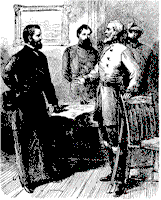 |
Return to Siege main page. Return to list of accounts. Go to previous page. |
